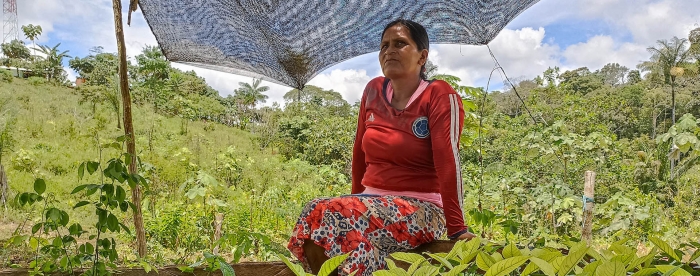News
Our stories ... ...

Colombia - 02 June, 2023
Tropenbos Colombia supported participatory productive restoration as an alternative approach to the government’s large-scale tree planting efforts. Tropenbos Colombia enabled farmers to establish restoration plots, supported inclusive landscape governance, and explored options for innovative financing.
Significant parts of the Colombian Amazon region are degraded. This is caused, among others, by the expansion of cattle ranching and coca plantations, as well as the spraying of defoliant as part of an anti-drug programme. The central government’s approach to restoring these degraded lands is through large-scale and top-down tree planting efforts, using only a small number of fast-growing tree species. In the view of Tropenbos Colombia, this approach is risky. It pays no attention to the question of who is responsible for nurturing the seedlings and for ensuring that they can grow into mature trees. Tropenbos Colombia therefore put forward a proposition for an alternative approach: participatory productive restoration (PPR).
PPR is based on the idea that restoration will be most successful when it engages communities and provides them with benefits, such as access to timber, fruits, firewood and water. By involving local communities, the restoration process becomes more sustainable, since the communities take ownership of the restored areas and are more likely to maintain them.
In the context of the Working Landscapes programme, Tropenbos Colombia has promoted PPR in the Solano landscape in the southern department of Caquetá. This area has undergone rapid land-use changes in recent years, leading to widespread degradation, mostly due to the expansion of cattle pastures. Tropenbos Colombia has helped local people to establish restoration plots, while also improving governance and promoting business and finance in support of PPR.
At the start of the Working Landscapes programme, Tropenbos Colombia invited Indigenous farmers and cattle ranchers in the Solano landscape to develop proposals for small-scale restoration initiatives. Tropenbos Colombia then provided technical support and a modest budget for seedlings and fencing materials, resulting in over one hundred local restoration plots — each tailored to specific ecological conditions and requirements. By the end of 2022, these areas were covered with a large variety of young trees, nurtured by their caretakers.
Tropenbos Colombia witnessed formerly deforested areas coming back to life. Farmers recognized the power of restoration and its potential benefits for both them and the environment. They are enthusiastic about the approach, and have been extending PPR initiatives themselves. For example, communities that established tree nurseries with the help of Tropenbos Colombia have started providing seedlings to other communities, and some have applied for additional financial support to expand the area being restored. In addition, Tropenbos Colombia noticed a remarkable shift in attitude among the participating cattle ranchers. Whereas they once viewed the forest as an adversary, they have now come to regard it as an ally in securing their long-term livelihoods. They have begun to see themselves as guardians of the forest, committed to its preservation.
Tropenbos Colombia views PPR as part of an alternative rural development model in which local communities have rights to the natural resources they depend on, and are able to influence the decisions that affect the future of their immediate surroundings. Tropenbos Colombia therefore took steps to enhance the involvement of Indigenous and peasant communities in decision-making processes at the landscape level.
Enthused by the success of the restoration initiatives, community representatives were keen to promote PPR at the municipal government level. With the help of Tropenbos Colombia they prepared themselves to participate during consultation meetings where stakeholders could provide input and feedback to municipal plans. They were able to make a convincing argument, backed up by data, maps and infographics. As a result, the municipal government decided to incorporate areas for PPR as a distinct category in its spatial plan, and in its plan to stop deforestation (affecting an area of around 1,5 million ha with approximately 10,600 people).
The adoption of PPR could be accelerated through innovative business models and financing mechanisms. In his inauguration speech in August 2022, Colombia’s new president stated that one such financial mechanism — known as a debt-for-nature swap — was a viable way to conserve the country’s forest. This mechanism allows countries to have their debts decreased in exchange for their participation in environmentally-friendly initiatives.
In the view of Tropenbos Colombia, debt-for-nature swaps could be used to support PPR, helping communities to build something that has value independent of external financial support. In the second half of 2022, Tropenbos Colombia therefore started presenting this idea to economists and financial experts from Vision Amazonia, a large government programme to prevent deforestation in the Amazon. The response was positive. Tropenbos Colombia will work with the programme to ensure that the government will use debt-for-nature swaps to invest in locally owned environmentally friendly initiatives that directly benefit local communities.
In only three years, the work of Tropenbos Colombia to promote PPR has resulted in tangible changes in the Solano landscape, as well as changes to the spatial plans of the municipal government. Inspired by these successes, several other NGOs are now eager to support farmers in developing and implementing restoration initiatives. And, following discussions with Tropenbos Colombia, Vision Amazonia is considering including some elements of PPR in its strategy for the deforested parts of the Amazon basin. They realize that, in the long term, PPR is more sustainable than the government’s large-scale tree-planting projects. Crucially, it all starts with the Indigenous people and peasants themselves. They are key to ensuring that tree-planting efforts will ultimately contribute to long-term climate, biodiversity and livelihood objectives.
This article is part of the TBI Annual review 2022.